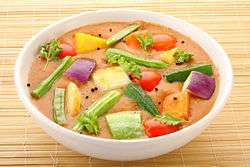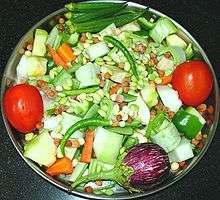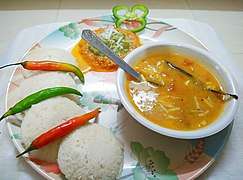Sambar (dish)
 | |
| Type | Stew or chowder |
|---|---|
| Place of origin | India |
| Region or state | South India, Sri Lanka, Myanmar |
| Main ingredients | Tamarind broth, lentils, vegetables |
Sambar, also spelled sambhar or sambaar, and pronounced saambaar, is a lentil-based vegetable stew or chowder, originating from the Indian subcontinent, cooked with a tamarind broth. It is popular in South Indian and Sri Lankan cuisines.
According to food historian K. T. Achaya, the earliest extant mention of sambar in literature can be dated to the 17th century.[1] According to a story, the dish was accidentally invented by the Maratha ruler Sambhaji, who added tamarind while making dal soup, when his head chef was away.[2]
Preparation

Sambar is made either exclusively with one of these vegetables or a combination of them:
- okra
- moringa
- carrot
- radish
- pumpkin
- potato
- tomato
- brinjal (eggplant)
- whole or halved shallots or onions.
Sambar often contains sambar powder, a coarse spice mix made of roasted lentils, dried whole red chilies, fenugreek seeds, coriander seeds and sometimes asafoetida and curry leaves. Regional variations include cumin, black pepper, grated coconut, cinnamon, or other spices.
The vegetables, tamarind pulp, sambar powder, turmeric, salt, and asafoetida are boiled together until the vegetables are half-cooked. Then the cooked lentils (most often the split pigeon pea) are added and allowed to cook until the vegetables are done. A spice-scented oil is added to the cooked sambar for extra flavor and tempering, and the dish is served garnished with fresh coriander leaves or curry leaves.
The addition of spice-scented oils, made by popping mustard seeds and other ingredients in hot vegetable oil, at the end of cooking is a common Indian culinary technique. A combination of mustard seeds, black gram, dried red chillies, and curry leaves fried in ghee or vegetable oil is one example of numerous oil flavourings used for sambar. Some variations include additional ingredients such as cumin seeds, shallots, fenugreek seeds and asafoetida powder.
Variations
Sambar is reflective of a broad and ancient tradition of lentil-based vegetable stews in southern India. In regions that grow coconuts, notably some areas of Kerala, coastal Karnataka and Tamil Nadu, Sambar is made with a paste of fresh, grated and roasted coconuts and spices, instead of sambar powder.
In Andhra Pradesh, it is called as Pappu chaaru. Apart from dal and tamarind, vegetables used in preparing is few. Vegetables are onions, dosakaaya, bitter gourd and tomatoes.
Sambar without lentils (but with vegetables, or dried or fresh fish) is called kuzhambu in Tamil Nadu.
Serving
Sambar is usually served with steamed rice as one of the main courses of both formal and everyday south Indian cuisine. A two-course meal of sambar mixed with rice and eaten with some sort of vegetable side dish, followed by yoghurt mixed with rice, is a prime southern Indian staple.
Vada sambar and idli sambar are popular for breakfast or an evening snack in the south Indian states. Roadside restaurants often offer free refills of sambar for iddli and vadas.
Sambar is also served as a side dish for dosa.
- Common sambar serving
 Sambar served with idli
Sambar served with idli Batata Vada sambar
Batata Vada sambar Coconut sambar
Coconut sambar
See also
References
| Wikimedia Commons has media related to Sambar (dish). |
- ↑ G. J. V. Prasad (2017). "Idli, Dosai, Sambar, Coffee: Consuming Tamil Identity". In Shweta Rao Garg; Deepti Gupta. The English Paradigm in India: Essays in Language, Literature and Culture. Springer Singapore. pp. 98–99. ISBN 978-981-10-5332-0.
- ↑ Sambar: the great Tamil dish of Maharashtrians


